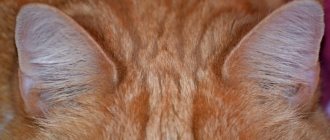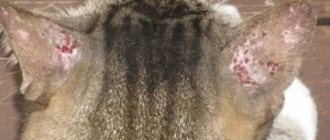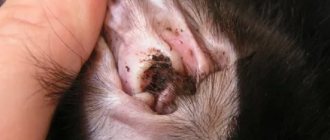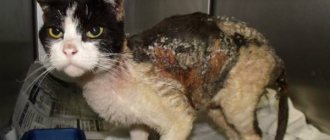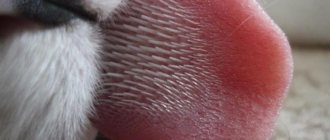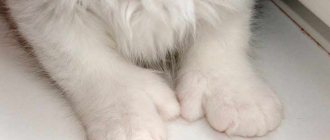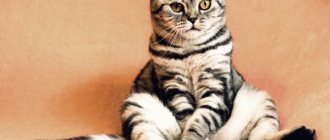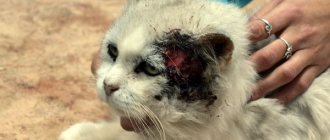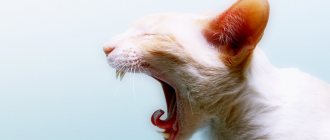Hair loss in animals is not so bad if it happens in small quantities, and the coat itself is renewed and remains shiny and silky. All “woolen” pets are subject to seasonal shedding. However, if a cat’s hair falls out in clumps to the point of bald spots or sores appear, then this is a serious reason to seek help from a veterinarian. Why does this happen? Why do cats get dandruff? And most importantly, what should the owner do?
Why does a cat go bald: reasons
Baldness (alopecia) leads to the appearance of bare patches of skin on your pet's body.
If there is too much hair, bald spots appear, the animal behaves restlessly
The main reasons for the development of pathology:
- allergic reaction;
- damage by fleas, lice;
- the presence of a scabies parasite;
- otodectosis (ear mites);
- fungal or lichen infections (dermatomycosis, dermatophytosis);
- pyoderma;
- purulent formations on the skin;
- oily seborrhea;
- deficiency or excess of thyroid hormones;
- increased work of the adrenal glands;
- diabetes;
- genetic predisposition;
- stress;
- lack of vitamins;
- chronic diseases of internal organs.
Important! A common cause of alopecia is food allergies. It is not recommended to give pets food from the human table. Veterinarians advise buying specialized food that contains the necessary vitamins and minerals.
The cat itches until it hurts and the hair falls out: How to treat it at home?
Every owner should understand that many drugs that can be used by humans and other animals cannot be used on cats.
For example, skin lesions are often treated with Yam BK ointment. This is strictly forbidden, since the tar contained in this drug is toxic to cats.
Like this article? Read other materials about cats on our website: How to give medicine to a cat? Tips for ensuring comfort for a cat - https://strazhchistoty.ru/cleanup/cleancats/kak-dat-lekarstvo-koshke.html How to learn to understand your cat (Practical tips) - https://strazhchistoty.ru/cleanup/cleancats/kak -ponimat-koshku.html
How can you help yourself without causing harm?
Try to limit access to the body area if the cat injures itself. A protective collar or blanket can help with this.
Trim your cat's claws or apply safe anti-scratch pads.
Itching can be controlled using a suspension or spray with the same name Stop Itching . It is important to understand that you will only remove the symptom, and after a course of the drug the problem may return.
The crusts can be soaked and removed using saline or Chlorhexedine.
Also, if there has been no treatment for fleas and ticks for a long time (the apple tree is a month old), it is worth doing it. Suitable drugs: Stronghold, Lawyer, Helmintal, Inspector, Bravecto.
And, of course, we recommend taking your pet to see a doctor as soon as possible.
Symptoms of hair loss in cats
A healthy cat should have soft and silky fur.
Partial alopecia on the back of a cat
Severe hair loss requires treatment. Alopecia usually begins to manifest itself with the appearance of bald spots on a cat in one area of the body, and other areas of baldness gradually appear.
The skin at the site of loss may be rough and red with small wounds. If the area of a cat’s bald spot is painful or itchy, the animal reacts aggressively to touch.
Types of alopecia
In veterinary medicine and medicine, the term “alopecia” is used, which means pathological thinning or complete loss of hair in a certain area of a cat’s body.
There are 2 forms of the disease, which can be classified according to the location of the bald patches:
- Diffuse or generalized alopecia is profuse hair loss throughout the body, which leads to significant thinning of the hairline.
- Zonal (focal) alopecia - when hair comes out on a certain area of the body (head, paw, neck, tail).
Alopecia can also be:
- self-induced (self-induced);
- spontaneous (against the background of calcium, zinc and iron deficiency in the cat’s body);
- parasitic (fleas, subcutaneous mites);
- genetic;
- post-traumatic, postoperative.
Self-induced (self-induced)
This type of alopecia is quite common among decorative cat breeds living in apartments. Out of boredom, stress, or for other reasons, the cat begins to lick itself frequently, stopping at certain areas of the body. As a result, the fur becomes thinner and falls out, and constant exposure to the cat's rough tongue prevents the growth of new undercoat. From the outside it looks like a hairless pink spot without injuries or sores. It takes a long time to deal with the problem.
The best and proven methods:
- Purchase a cat diffuser or spray to diffuse pheromones or essential oils. For example, Feliway (pheromones stabilize the cat’s emotional background and reduce unusual forms of stressful behavior) or Relaxivet (lavender, rosemary and geranium oils relieve nervous tension and anxiety).
- Eliminate the cause of stress (get a second cat, fish, buy new toys, a scratching post house, build loopholes or tunnels for exciting leisure time for kittens in the absence of their owners). This will distract your pet from its excessive hygiene.
Sometimes a cat independently licks one area of the body where it feels pain, itching, or burning. This usually occurs after injections into the withers, vaccinations, when applying bandages or the formation of a tumor.
If the cause of anxiety is eliminated, the animal will calm down. You can resort to using a protective collar, which is sold at a pet store.
Independent (spontaneous)
This type of baldness in cats is the most unpredictable and mysterious, because it appears spontaneously and for no particular reason. The fur falls out and does not grow back. Diagnosis is carried out with the participation of a veterinarian in the clinic, who will clarify the following information from the animal owner:
- What is the diet and have there been any changes in the cat’s diet recently? A sudden change in food can cause thinning of the coat (especially if there is food intolerance or the new food is of poorer quality).
- What medications does your pet take and what is it being treated for? Taking some medications can cause your cat's fur to fall out in clumps. Once treatment is complete, the hair will grow back.
- Have you had contact with other animals? This may be the cause of the development of parasitic diseases on the skin.
- What operations did the cat undergo? There may be no fur at the suture site for a long time.
- Whether there were matings, births (lactation period and kittens) and when.
- Did the cat fall from a height or receive other injuries (strong impacts provoke irreversible processes on the skin).
Important! Only after a complete history has been collected and a series of laboratory tests have been carried out, will the veterinarian be able to determine the cause of the disease and diagnose the cat.
Diagnosis of alopecia in different parts of the body
Only a doctor can determine why a cat is going bald. The basis of diagnosis includes medical history, visual examination, and microscopic examination of hair roots.
Be sure to read:
Sores on a cat’s neck that itch and hair falls out: normal or pathological, reasons, what to do
The pet’s blood is examined and a scraping is taken from the skin. If a tumor is suspected, an x-ray or ultrasound is performed.
The diagnosis is partially helped by the localization of bald spots on a cat:
- Symmetrical baldness of the abdomen, thighs, sides, and front legs is a characteristic symptom of a skin disease.
- Due to stress, cats tear out hairs in the anus , on the back, paws, stomach, and inner thighs. This happens especially often in the following breeds: Siamese, Abyssinian, Himalayan.
- Hormonal disorders are usually indicated by alopecia on the bridge of the nose , base of the tail, hips, and chest. The skin ceases to be elastic.
- In the case of a lack of thyroid hormones, pet hair is easily pulled out in the pelvic area , on the stomach, chest and neck.
- Cancerous formations provoke bald spots on the stomach, chest, and paws . Oncology can cause complete hair loss.
- Vitamin deficiency is characterized by the appearance of small, round bald patches, which can unite. The skin in places where there is no fur is bright pink.
- Fungal infections are characterized by the appearance of bald spots with scaly, cracked skin.
Scratching a pet's skin is dangerous due to infection and the development of an inflammatory process.
To make it easier for you to determine the cause of your pet's baldness, we have prepared a table. It contains all the main pathologies accompanied by hair loss in a cat:
Diagnosis of the disease
If a cat's hair falls out in clumps before bald spots form, it should definitely be seen by a specialist. Only a veterinarian can accurately determine the diagnosis. To determine the disease and prescribe the correct treatment, the doctor must:
- Find out how and when the disease manifested itself. The owner will have to tell in great detail the animal’s lifestyle, what the pet ate and drank, what it came into contact with, and whether it walked outside.
- Examine the patient.
- Examine hair roots under a microscope.
- You may need blood and hormone test data, and a scraping will be required.
- Sometimes an ultrasound or x-ray is done to confirm or rule out the presence of tumors.
How to treat baldness, what to do, how to help at home?
Therapy for the disease is aimed at eliminating the causes of alopecia:
- For allergies, contact with the allergen is eliminated, the use of anti-allergy drugs, immunostimulants, and diet are effective.
- For parasitic lesions, shampoo, ointment, and spray are prescribed.
- Pyoderma and abscesses are eliminated by excision of the affected skin, antibiotics and antiseptics are used to treat wounds.
- Stressful conditions are corrected by taking sedatives.
- Malfunctions of the thyroid gland are treated with hormonal medications; if a tumor develops, surgery is prescribed.
- Bacterial folliculitis is treated with antibiotics, usually amoxicillin. The pet is washed with medicated shampoo.
- For ringworm, the hair needs to be cut, Ketoconazole, Itraconazole, Griseofulvin are taken orally.
Important! Bald spots in cats caused by hereditary causes cannot be treated.
Other diseases
Veterinarians include helminthiasis, allergic reactions, autoimmune pathologies and dysfunction of internal organs as other causes of receding hairline and bald spots. Hair loss is just the least of the problems. In some cases, an animal left without treatment may die.
Infection with worms
The waste products of worms lead to severe intoxication of the body and gradual failure of internal organs. An infected animal loses its appetite, vomiting and diarrhea. His fur is thinning and dull. Despite the dramatic weight loss, the belly remains round and firm.
Allergy
Allergies can be food or non-food. Detecting the allergen on your own is problematic, so treatment is often prescribed before the pathogen is identified.
In addition to alopecia, an allergic reaction from the skin may be accompanied by severe itching. Scratching can cause the damaged areas to become red, flaky, and blistered or eczema-like. Tearfulness, rhinitis and gastrointestinal disorders may occur.
Autoimmune diseases
Autoimmune (focal) alopecia is a malfunction of the body. Immune cells begin to produce antibodies to destroy their own cells, mistaking them for foreign ones. Hair follicles are affected. Antibodies not only destroy existing hairs, but also prevent the formation of new ones. Bald areas are no longer restored.
This disease, like all immune pathologies, is very rare. Areas affected by alopecia grow over time. Without timely treatment, the condition of the coat will only worsen. The sides, groin and thighs of the animal are primarily affected.
Hyperthyroidism
Hyperthyroidism is a pathology of the thyroid gland that disrupts the natural amount of hormones produced. Due to increased levels of hormones, the cat develops seborrhea. He constantly licks himself, and when he is stroked, tufts of fur remain on his hands.
Hyperthyroidism is a secondary disease. It occurs with pathologies of the liver and kidneys, disorders in the gastrointestinal tract and immune system. In addition to alopecia, symptoms may include diarrhea, vomiting, loss of appetite, increased urination and weight loss.
Baldness in cats, how to deal with shedding: advice from a veterinarian
Seasonal shedding is normal. This period is especially noticeable for owners of long-haired pets. Molting can last from 2 weeks to 3 months. Veterinarians advise washing and combing animals more often during this time.
Be sure to read:
A cat's belly is going bald: physiological and pathological reasons, what to do, how to treat it
Effective shampoos against hair loss:
- "Phytoelite" from "Veda";
- SynergyLabs Shed-X Cat;
- Perfect Coat 8 in 1.
It is useful to take vitamin complexes, preferably in liquid form.
Bald spots in cats caused by hereditary causes cannot be treated.
To remove hair from the stomach, it is recommended to give special medications:
- Pet Naturals of Vermont;
- Actipet;
- Vaseline oil, etc.
Ordinary grass can help get rid of lumps; in the summer, it is enough for the animal to go for a walk; in winter, the seeds can be purchased at pet stores and planted yourself.
If shedding is accompanied by specific signs, it is necessary to show the cat to a doctor.
The cat began to lose hair on his neck and behind his ears.
Daughter Sophia (07/11/08) and son Danilka (03/09/11) :)))
02.25.10 13:41 Reply to the message The cat began to lose hair on its neck and behind the ears by Tella222
Appearance is an eternal letter of recommendation
02.25.10 14:41 Reply to the message The cat began to lose hair on its neck and behind the ears by Tella222
Freedom for Angela Davis!
02.25.10 16:58 Reply to the message The cat began to lose hair on its neck and behind the ears by Tella222
The main difference between animals and people is that animals do not keep people in their homes. Although cats may not agree with me.
02/25/10 18:06 Reply to the message The cat began to lose hair on its neck and behind the ears by Tella222
Corrected by Merigold (25.02.10 18:11)
02/27/10 12:55 Reply to the message The cat began to lose hair on its neck and behind the ears by Tella222
Corrected by user Ryzhinka (27.02.10 13:17)
02/27/10 23:31 Reply to message Re: The cat began to lose hair on its neck and behind the ears of user dm666
Daughter Sophia (07/11/08) and son Danilka (03/09/11) :)))
02/27/10 23:35 Reply to message Re: The cat began to lose hair on its neck and behind the ears by user Tattunhamon
In response to: Sorry, I didn’t quite understand. The cat’s entire neck is bald, it’s starting to fall out behind the ears, but you haven’t been to the doctors yet and have started a problem? What to do. Run to the doctor.
Daughter Sophia (07/11/08) and son Danilka (03/09/11) :)))
02.28.10 13:30 Reply to message Re: The cat began to lose hair on its neck and behind the ears by user Tella222
El saber no ocupa lugar
02.28.10 13:54 Reply to message Re: The cat began to lose hair on its neck and behind the ears by user Tella222
Well, I dropped everything and ran. The cat is really scary to look at, but the child is more precious to me, and my husband doesn’t care about the cat.
It's amazing how you treat an animal, which is completely up to you! Why did you even get a live cat? Are you too lazy to pick it up? That’s right, the cat is not a child, he won’t say that he’s bothering him and he won’t tell on his mother to the neighbors.. They dragged the husband in for some reason.. And the baby seems to spend 24 hours a day at your breast continuously, since you can’t “throw away”
Preventing hair loss in cats
To protect your pet from the unpleasant symptoms of hair loss, owners need to follow several rules:
- Provide your cat with a balanced diet.
- Avoid factors that provoke stress.
- Vaccinate against infectious diseases on time.
- Avoid contact between a healthy animal and a sick one.
- Treat wool promptly when parasites appear.
- Carry out preventive examinations regularly.
Prevention measures
To protect your family pet from skin diseases that are accompanied by baldness, it is necessary to provide proper care for the cat:
- The first and most important thing is preventive examinations. You can do them yourself. While bathing, brushing, playing with the cat. Regular monitoring will ensure that you do not miss the appearance of alarming symptoms.
- Timely vaccinations against infectious diseases will improve your pet's health.
- Regular (once every 4-5 months) antiparasitic treatment is a shield against skin diseases.
- Deworming medications are required for all cats.
- A calm and friendly atmosphere in the family without stress and scandals is useful not only for people, but also for cats.
- If the cat is about to move, change owners, or the house is about to be renovated, a good solution would be to buy sedatives for the pet.
- You should not allow contact with unfamiliar animals - they can be carriers of the causative agent of alopecia.
- A balanced diet and proper nutrition are the key to a healthy cat.
To preserve not only the health, but also the beauty of your pet, it is important to be an attentive and sensitive owner. Taking timely measures will eliminate the disease at the very beginning - and this will relieve stress for both the cat and the owner. And it is important to always remember that self-medication can seriously aggravate the course of the disease.
Why do hairballs form?
Scientifically, the wool balls or sausages that form in the stomach and intestines of a cat are called trichobezoar (“hair tumor”) - a mixture of hairs, food debris and gastric mucus.
Sometimes a cat vomits hair
The reason for their formation is that representatives of the cat family carefully care for their fur using their tongue. The fact is that it is covered with small hook-shaped growths, which, when licked, pick up hairs. Next, individual hairs pass into the animal’s stomach, where they accumulate in the form of balls or sausages and are periodically released with vomit.
Small accumulations pass through the digestive tract further into the duodenum and small intestine, then are excreted in the feces. A large lump can get stuck in the intestines and cause constipation or obstruction, stricture and esophagitis.
Hairballs from a cat's stomach
Natural causes
If the ingested hairs are not excreted, the cat will periodically regurgitate the hair to remove these non-food items from the stomach. Because the wool masses pass through a narrow esophagus, they look like sausages. In this case, vomiting is accompanied by coughing sounds.
In long-haired breeds (Persians, Maine Coons and others), this natural cause of the formation of trichobezoars is most common - they can spend more than 10% of their time licking their coat.
Cats swallow fur when licking themselves.
Additional Information! Kittens practically never have such lumps in their vomit, because they are licked by the mother cat, but as they grow, vomiting of swallowed fur in a young cat becomes more and more common.
The cause of vomiting itself can also be grass specially eaten by the animal for cleansing.
Dangerous reasons
If your cat vomits hair quite often, you need to visit a veterinary clinic so as not to miss the onset of a serious illness in your pet.
So, some dangerous reasons why a cat pulls out hairballs and swallows them are:
- Flea infestation. At the same time, the volume of ingested fur sharply increases as a result of itching from bites.
- Allergic dermatitis and other skin problems, the symptoms of which are unbearable itching.
- Being in stressful situations, when the animal licks itself to calm itself, as well as as a result of increased excitability of the sympathetic nerves.
- Chronic diseases of the gastrointestinal tract due to an inappropriate diet, accompanied by impaired motility of the upper digestive tract.
- Diabetes, kidney and thyroid diseases, intestinal inflammation.
Medicines
Removing parasites is the first step to fluffy, beautiful fur. First, an insecticidal treatment is carried out aimed at exterminating lice, fleas, and ticks. For this purpose, drops, sprays, and shampoos are purchased at the zoological pharmacy. They should be used strictly according to the instructions, without exceeding the concentration, dosage, or procedure time, so as not to poison the pet.
Be sure to read:
Why does a cat constantly scratch its chin: what kind of disease is it?
The use of dichlorvos and other chemicals not intended for cats is strictly prohibited. If there are a large number of fleas, the treatment is repeated after 7-10 days. Suprastin and diazolin in the dosage recommended by the veterinarian will help relieve itching.
3-7 days after treating the external parasites, a drug is given to remove helminths. The tablet is taken in the morning, along with food, the required dose is calculated according to the cat’s weight. If worms are found in the stool after this, you need to repeat taking the drug after 10-14 days.
Symptoms of having fur in the stomach
Why does a cat vomit after dry food?
To avoid further problems with the gastrointestinal tract, the owner of the animal must be able to recognize the situation when excess hairy mass accumulates in the pet’s stomach and it is necessary to take action. So, the warning signs are:
- The animal refuses to eat or eats less than the usual portion because the stomach is already filled with hairballs. The cat will constantly stomp around the bowl, as if not knowing what to do, because the level of glucose in the blood is low from hunger, but the stomach is full.
- The fur becomes dull and no longer shines, which is caused by the animal not receiving the necessary nutrients.
- Periodic coughing and urge to vomit. The larger the resulting lump, the more difficult it is for the animal to get rid of it when the cat vomits hair because the gastric sphincter does not open wide enough.
- The presence of stuck (or worse, ingrown into the gums) hairs on the cat’s teeth. Having discovered them, it is necessary to take measures to clear the digestive tract of trichobezoars.
- The cat becomes lethargic and apathetic, constantly sleeps and does not play, as usual, avoids communication.
- Constipation that lasts more than one day. This situation can arise as a result of the stomach being completely filled with swallowed wool and often leads to general intoxication of the animal’s body.
- The cat is vomiting in masses mixed with blood.
